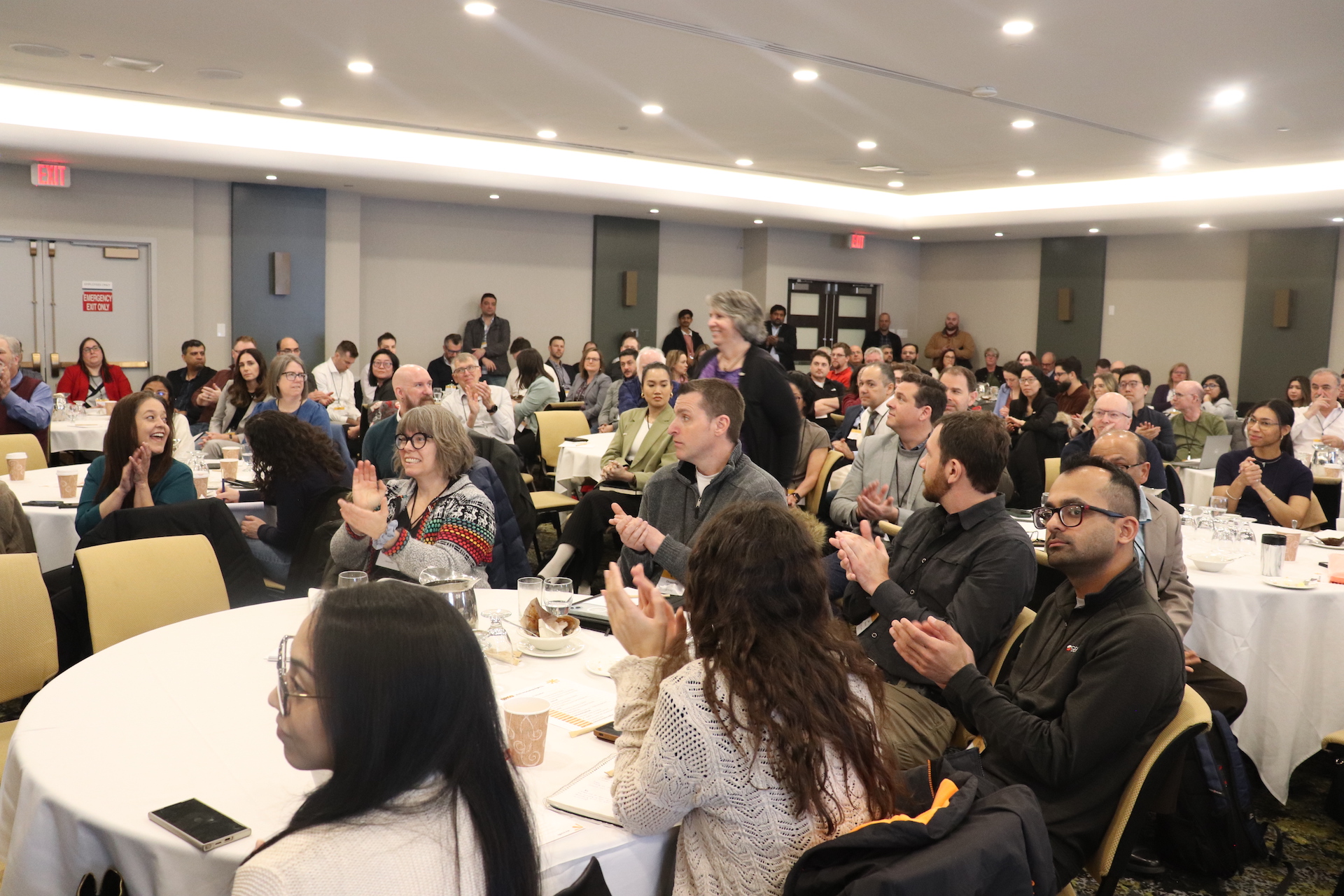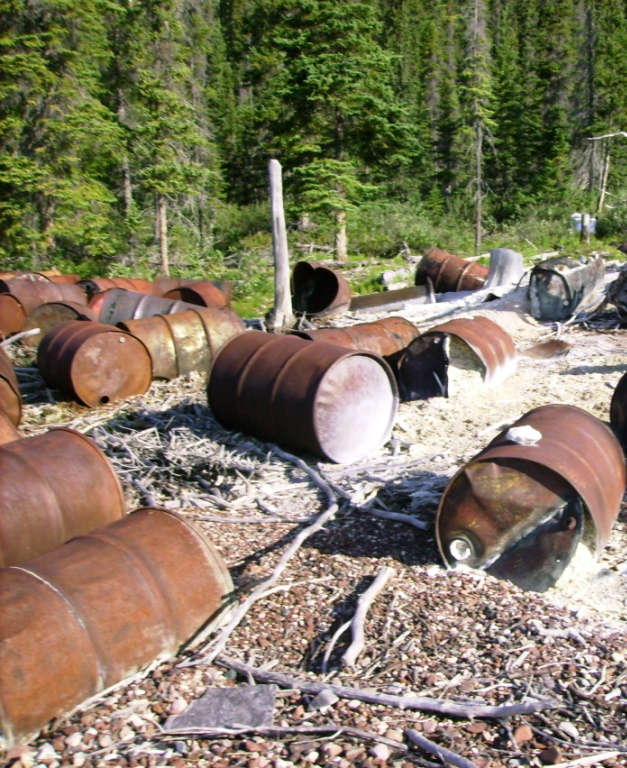Tuesday, October 7, 2025
Approximately 200 members of the Qualified Persons Community of Ontario (QPCO) came together on April 2, 2025 for the inaugural QPCO workshop, a day of discussion, educational presentations and networking at the Novotel Hotel in North York. The theme was “Raising the Bar,” as the organization works to set high standards and keep improving the quality of practice.
QPCO is a voluntary community of practice focused on sharing knowledge and practical experience, creating a forum for dialogue with government and regulatory bodies about issues faced by QPs, and creating opportunities for QPs to improve their knowledge and skills. QPCO is gaining traction in the industry and this year was awarded a Brownie Award for the “Reprogram” category recognizing outstanding legislation, policy and program initiatives.
“As QPCO was formed in 2021, a vision of a community that cares about learning more and becoming better QPs was front and centre. The success of our inaugural event on April 2 demonstrates that this is also a shared vision of our membership,” said Grant Walsom, Partner/Principal Engineer at Trace Associates Inc. and founder of QPCO. “The members of our community are learning that we can all learn from each other. I find this inspiring and it helps me continue to look for additional ways to ‘raise the bar’ for QPs in Ontario. I am extremely proud of our leadership group and the work that we continue to do.”
The four session blocks included topics such as legal liabilities, conceptual site models, case studies and more. Here’s a brief overview and some highlights of the technical advice delivered at the QPCO workshop.
Grant Walsom of Trace Associates, Freesia Waxman of Grounded Engineering and Janelle Yanishewski of the Ontario Environment Industry Association (ONEIA). They are sporting the signature QPCO team jerseys. Certain members were awarded jerseys throughout the day.
QPCO recommendations on soils
Hammad Din of Engtec Consulting Inc. dug into the QPCO recommendations for documentation improvements for excess soils. According to Din, “QPs need to talk to clients more, as there are many moving parts in an excess soil project.”
He cited the issues of volume discrepancies, multiple reports and the many acronyms within those reports as some of the common issues that arise. “The more people you have on speed dial, the easier it is to reconcile any issues.”
“We’re not just technical service providers, we are consultants and should put our neck on the line and give our opinions,” he emphasized. “Never hide behind and email; pick up the phone and talk about it.”
When it comes to soil management plans, he advised that it’s important to be aware of requirements from municipalities, summarize data clearly, have a plan of action for contractors, have a flexible document to fill gaps, and state data about the temporary storage of soils.
Mandatory certifications for risk assessments
Kathryn Matheson of SLR Consulting and Lara Alves Beese of Dillon Consulting Limited provided insights into considerations for signing mandatory certifications in risk assessments. Matheson advised that risk assessment teams include members with expertise in all of the disciplines required to complete the risk assessment. “A risk assessment should never be done in isolation by one person,” she said, adding that a risk assessment should over more than just risk calculations. “It should consider risk assessment assumptions, such as site assessment information and risk management recommendations.”
Matheson emphasized the importance of balancing challenges and risks, the importance of not insufficiently or incorrectly underestimate risk to human health and the environment while considering multiple lines of evidence to fill in smaller gaps and increase confidence in risk interpretation and management.
Alves said she likes to ask for more data. What should a QPRA keep in mind when planning a Risk management plan under Reg 153/04, which will require mandatory certifications? “Aways keep in mind that data should be sufficient to avoid underestimating risk.” She emphasized the need for high frequency data, which saves costs to end users and ensures scientifically sound reports.
The key takeaway here is “Keep the mandatory certifications in mind during the onset of a risk assessment: they need to be signed at the end.”
MECP updates
Adam Leus from the Ministry of Environment, Conservation and Parks (MECP) reported on a recent survey that indicated the ministry is meeting requests within a 30-day time frame 91 per cent of the time. Over time, the ministry has worked with consultants to reduce the number of iterations required to get an RSC filed. Currently the average is two and they are working on improving the clarity of expectations.


Adam Leus from the Ministry of Environment, Conservation and Parks (MECP) provides his presentation on Brownfields and Records of Site Condition and receives a QPCO team jersey.
Phase 2 Conceptual Site Models were also covered by Sridhar Sangaraji, who walked attendees through a few case studies. He noted that APECs (Areas of Potential Environmental Concern) and soil sample locations should be clearly labelled and the importance of details such as groundwater contours and flow direction outlining potential pathways.
“To tell the whole story, you need to provide remediation figures and basic information that make the eventual site model,” and he pointed to updates on the “Getting in Right” Guide, which was prepared in 2015 and amended in 2019.
He also pointed out common submission challenges, such as confusion over the “Owner’s account” (should be clear about if there’s a partnership or who the owners are) “Agent information” (if the QP is the agent be sure to use the Delegated Authority role), and validation of UTM coordinates.
Richard Saunders, a district engineer for five regions in Ontario, discussed Pre-Submission Forms (PSFs) and Risk Management Measures (RMMs).
These measures cover the development and implementation of one or more risk management measures which control or mitigate the level of risks to human health and the environment that are part of Risk Assessment.
A brief summary of the RMM is as follows:
- Part 1 of the CPU – Interpretation, for the meaning of all the defined capitalized terms that apply to the CPU.
- Part 2 – Legal Authority – A certificate of property use is binding on the executor, administrator, administrator with the will annexed, guardian of property or attorney for property of the person whom the property is under.
- Part 3 – Background – i.e., Residential use as defined in O. Reg 153/04.
- Part 4 – Director Requirements – Risk management measures specific to the property, such as soil and groundwater management plan and annual reports to maintain the property (a lot of the risk assessments in Toronto are condos). Site changes after the development is done. Property requirements – any other person with an interest in the property, before dealing with a property in any way.
- Part 5 – General – Requirements of the CPU are severable and if any requirement needs extra info.
- Part 6 – Information regarding a Heading before the Ontario Land Tribunal, including how to appeal a CPU.
- Schedules and Figures at back of CPU – i.e., Schedule A is Property Specific Standards (Soil and Groundwater) for each Contaminant of Concern.
There was also a discussion of BRAT, an excel-based tool that develops site-specific excess soil quality standards, including site-specific leachate screening levels and ceiling values.
Site-specific information can be incorporated in a few ways: modification of physical characteristics, site use characteristics, predefined risk management measures existing planning. There was a detailed discussion on the applicability of the BRAT. For example, the BRAT cannot be used if excess soil is designated as hazardous waste because O.Reg. 406/19 does not apply to soil that is hazardous waste. The BRAT also provides no relief for salt-related parameters. Additional considerations that QP should make is the physical characteristics of soil and how it changes in the transport.
Understanding laboratory QA/QC
Nihila Anthonypillai of AGAT Laboratories provided an in-depth overview of how to ensure accuracy (a measure of how near a result is to the “true value”) and precision (a measure of how well replicated measurements reproduce).
She discussed the intricacies of Field Quality Control Samples, referenced the CCME guidance manuals, and provided some useful case studies. Key takeaways included the following:
- Data quality starts in the field. Any discrepancies add to data uncertainty.
- The lab quality control measures make results reliable and defensible.
- Quality control limits established for lab QC are not the same for field QC samples.
- Ensure efficient sample volumes to increase the chance of your sample used to complete lab QA/QC.
- By controlling the various factors contributing to the overall uncertainty, the lab has an increased level of confidence in the data reported.
- Timely review of results for any follow-ups are required within holding times and sample shelf life.
Advanced site characterization models
Patrick O’Neill of VEI Contracting Inc. (formerly Vertex Environmental) discussed the evolution of the industry, from “superficial observation to environmental boreholes and groundwater wells.” He discussed progress in terms of site characterization technologies – including laser induced fluorescence probe, membrane interface probe, low level membrane interface probe, hydraulic profiling tool, groundwater samplers, nuclear magnetic resonance tool, downhole geophysics tech, XRF scanner, other the such as field labs and artificial intelligence and cone penetration tool and field test kits.
Utilizing a case study on managing offsite liability at a gas station, he emphasized some key takeaways. A small amount of work can make a big difference with the final results. A risk management measure can guarantee more thorough results.
Excess soils management
Bailey Waters of Grounded Engineering provided an overview of how to choose one drilling method over another, including references to common challenges such as restricted access, confined spaces, limited clearance, and flood conditions – and the implications for soil and ground water samples.
“Location, location, location,” said Waters. “Location is important. Trying to hit the spot with the highest source of contaminants.”
He pointed out how samples are effected by the various drilling methods, including: hollow-stem augering, mud rotary drilling, drill water/fluid (if tap water is used as drill water, the chlorine can react with organic matter), direct push (percussion/geoprobe), sonic drilling, and more. He also provided a cautionary note–if PFAS is a concern don’t use a Bentonite hold plug and when using the PVC riser be careful about soluble materials.
“Think about everything holistically and if you have one result that needs to be re-evaluated it’s good science to do it.”
Tom Li of Parsons Corporation joined Tabitha Lee of Watermark Corporation and Carolyn Adams of United Soils discussed various approaches and perspectives on the management of excess soil and pointed out how the definition has changed.
Their “Lessons for Owners and Owner’s QPs” include:
- Subsurface should be thoroughly characterized (define what rock is and what soil is)
- Allow contractors the opportunity to present alternatives in bids
- Clarify with preferred contractors their intentions for rock prior to award.
- Research potential receiving sites and include in tender.
- Negotiate with receiving sites.
They cautioned that they should not leave excess soil planning to contractors or design/build teams or just “hope for the best.”
Other recommendations and “ramblings” included:
- The public sector should better plan for resource reuse on projects, through discussions with design teams.
- Naturally occurring substances in common Ontario bedrock should be studied to determine the actual risk to groundwater.
- Addressing ambiguity on rock inflating infrastructure costs across the province.
Ethics and conflict of interest
You could hear a pin drop in the room as attendees listened to Jim Walls of R.J. Burnside and Associates discuss his experience with litigation involving a Director’s Order. “Is it legal and is it ethical?” asked Walls. “We work in a very evidence-based business.”
He implored attendees to do a “general self-assessment test” and ask themselves if what they were doing is legal, honest, and is it consistent with the Code of Ethics and professional conduct standards.
Ethical and conflict of interest scenarios he cited included the following:
- A company retains your professional services but doesn’t pay you…the ministry doesn’t return the ECA, but if they come back with comments than you just don’t address them.
- Working for two independent clients who’s interests unexpectedly conflict such as representing a fill site and a project generating fill.
- Accepting gifts from contractors or clients – a box of chocolates versus a trip to Las Vegas?
- Cost of a misstep – legal action for compensation, reputational damage, potential enforcement action under the EPA
Walls, along with engaged attendees, discussed the challenges of listening to your gut, responding to emergencies and a duty to the public to act accordingly while risking personal liability.
Janet Bobechko of WeirFoulds LLP also provided a riveting discussion on QP liability. “Ethical standards and legal liability are very closely tied together,” explained Bobechko. “It’s important to understand who you are as a Qualified Person and make sure you’re on track.”
Bobechko raised several critical points, including the following:
- Section 28 – A QP should retain any document or record prepared by the QP for seven years after the date the document is prepared (you personally, not the company).
- Insurance for QPs is important to protect professional liability and environmental liability, etc.
- Possible conviction – Christopher Follett, a professional engineer, was convicted April 2024 of one violation (count) under the Environmental Protection Act, fined $12,000 plus a victim fine surcharge of $3,000 for providing false and misleading information. Google provided the initial emails that provided the forged documents. In his guilty plea, Follett admitted that he intentionally lied to the ministry on two occasions in 2021.
- Everyone should know that there is statutory protection for EPA investigations.
- The industry is still waiting for proposed Administrative Monetary Penalties for O. Reg. 406/19 – but there is one for QPs who fail to provide Ministry with declarations and worksheets for BRAT.
- QP Contractual Liability – Be careful of sending a thumbs up in a text – it can be a binding contract!
- Scope of work is what you’re judged against, contractual limitations are the cost of doing business, and be careful with reliance letters (get paid before you provide them – do not issue it until you’ve been paid).
- Duty of care (you owe a duty of care and becomes important to how to carry out work – standard operating procedures and training) and procedures.
Bobechko advised QPs to: “Take a minute, take a breath and go back to first principles and do QA/QC. When people say they need something yesterday, you have to push back to make sure you’re doing things right. Don’t be afraid to speak up.”
Panel: What experienced QPs want us to know
Freesia Waxman engaged experienced QPs Carolyn Adams, David Hopper, Shannon Hunt, Tony Missiuna, David Hopper and Shannon Hunt to discuss the state of the industry and provide advice for the next gen.
“I put in a lot of work in the field so by the time I was a project manager I knew how to manage them,” said Missiuna. “And he had a lot of good mentors.”
“When we write conclusions we try to be as succinct as possible,” stated Adams. “But being conservative can cost people money, so it’s good to be correct.”
How do you prepare for negotiations? “Knowing all the positions and roles is a good start. It’s also important to be fair and consistent,” said Hopper. “The ass you’re kicking today may be the ass you’re kissing tomorrow.”
On dealing with difficult clients Hopper says communication is important.
“I really believe in the concept of ‘call a friend,’” shared Hunt. “There are lots of multi-disciplinary projects these days, with many QPs involved in a project.” She cited QPCO and how it has been “an amazing place for cooperation and collaboration on ideas.”
What’s the best quality a junior employee can have in one word? The panel offered the following: communication (of goals and action plans), reliability (sticking to deadlines), ownership (of projects and when things go wrong), curiosity (necessary to finding solutions when things don’t fall into place), and driven (to be responsive).
Concluding thoughts about the inaugural QPCO workshop were positive and point to future opportunities already in the works.
“Many people commented that the atmosphere of this event was unlike others they’ve been to. The focus on QPs for an entire day brought everyone together with an amazing collaborative vibe to the room,” said Freesia Waxman, Team Lead for Environmental Engineering Services at Grounded Engineering Inc. “The sponsorship support was truly overwhelming and blew us away. You could feel the excitement for the next workshop already! We had many people eager to participate and help move forward with new initiatives and even topics for next year. As a group, I think we walked away with a sense of camaraderie and forward focus. Now we’re wondering how to make the workshop even better next year, and that’s a good problem to have.”
The Ontario Environment Industry Association (ONEIA) is in the process of providing copies of presentations to attendees. For further information, click here. Or email info@ONEIA.ca.















